Heading North from Rome along the Via Flaminia to the rustic hill towns of Umbria. Ancient Roman ruins dot the countryside of this mystic region known for producing the most Saints in Italy. The hilltown of Narni is like stepping through the wardrobe into a medieval wonderland. I hope we get to meet Aslan...
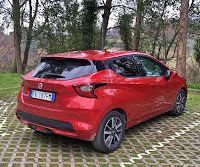 |
| Lil' Red Micra |
At this small office across from Vatican City, there was no lineup, and our car was ready and waiting for us when we arrived. They didn't have the Fiat 500L that we reserved, which was a bummer, but the man at Hertz threw in the chains we required for free. Wait-what? Chains, for like, snow? Oh great!
 |
| Via Flaminia- We Took The Pink Route On The Right |
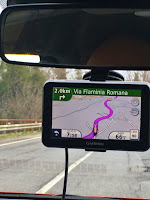 The Via Flaminia is another ancient Roman Road like the Via Appia that connects Rome with ports along the North Adriatic like Pesaro and Rimini (Pesarium and Ariminum in Latin). This was no easy feat because between Rome and Rimini are the Apennine Mountains. The modern road still follows much of the same route built by Gaius Flaminius in 220 B.C.E. The Via Flaminia technically starts in Rome at the Porta del Popolo in the Aurelian Walls of Piazza del Popolo. That's where we hooked up with the Via Flaminia and headed North on the Strada Regionale 3 or SR3. On the way out of Rome on the Via Flaminia, you pass by the Villa of Livia, the famous first lady of Rome's country villa. Much work has been done excavating and restoring Villa Livia, and it is one place I would love to check out some time.
The Via Flaminia is another ancient Roman Road like the Via Appia that connects Rome with ports along the North Adriatic like Pesaro and Rimini (Pesarium and Ariminum in Latin). This was no easy feat because between Rome and Rimini are the Apennine Mountains. The modern road still follows much of the same route built by Gaius Flaminius in 220 B.C.E. The Via Flaminia technically starts in Rome at the Porta del Popolo in the Aurelian Walls of Piazza del Popolo. That's where we hooked up with the Via Flaminia and headed North on the Strada Regionale 3 or SR3. On the way out of Rome on the Via Flaminia, you pass by the Villa of Livia, the famous first lady of Rome's country villa. Much work has been done excavating and restoring Villa Livia, and it is one place I would love to check out some time. Very quickly, the city gave way to farmland and then we were in the highlands above the Tiber River valley that flows to Rome. The hills were so green and forested, dotted with olive groves and villas on ridges with fantastic views. Following the SR3, we sharply dropped down to the valley floor in a series of sharp switchbacks and crossed the Tiber river, which is the regional border from Lazio into Umbria. Umbria is known as "The green heart of Italy," and the pig (and truffle) is king in Umbria. Here the pig farms free range their pigs on ranches, so the pigs can eat nuts, berries and mushrooms that grow in the forests. There were also many hunters out in their camo gear and pick-up trucks hunting cinghiale or wild boar. We saw a recently shot cinghiale loaded into the back of the pick-up truck on the side of the road. It was SO big; it took up the whole box of the truck with its legs sticking out! The locals tell me the cinghiale do a lot of damage to their farms and vineyards, utterly devastating whole rows of grapevines overnight.
Very quickly, the city gave way to farmland and then we were in the highlands above the Tiber River valley that flows to Rome. The hills were so green and forested, dotted with olive groves and villas on ridges with fantastic views. Following the SR3, we sharply dropped down to the valley floor in a series of sharp switchbacks and crossed the Tiber river, which is the regional border from Lazio into Umbria. Umbria is known as "The green heart of Italy," and the pig (and truffle) is king in Umbria. Here the pig farms free range their pigs on ranches, so the pigs can eat nuts, berries and mushrooms that grow in the forests. There were also many hunters out in their camo gear and pick-up trucks hunting cinghiale or wild boar. We saw a recently shot cinghiale loaded into the back of the pick-up truck on the side of the road. It was SO big; it took up the whole box of the truck with its legs sticking out! The locals tell me the cinghiale do a lot of damage to their farms and vineyards, utterly devastating whole rows of grapevines overnight.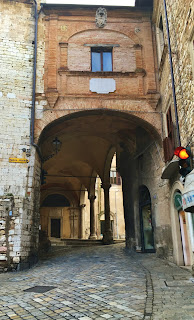 |
| Under The Duomo |
 |
| We found Aslan! |
Our little regional road, which is the path that Roman troops trudged along 2 millennia ago, crossed under the ultra-modern A1 Toll highway that heads to Florence. We pass by ancient Roman towns like Otricoli and Vigne, and the road starts to wind and climb again up into the misty mountains towards a village called Narni. Narni is the geographic centre of Italy, and its Latin name is Narnia, the same Narnia that C.S Lewis names his classic children's book series "The Chronicles of Narnia" after this historic town. Now we HAD to see this place. Besides, it was time for the "pranzo prowl"-we needed some lunch! TIP #2: In small towns in Italy, lunch is served in RESTAURANTS from noon until about 2:00-2:30. THEY DONT OPEN AGAIN UNTIL 7:00 FOR DINNER. In many small towns during holiday or offseason, there is only one place that serves lunch, so one must be mindful.
 |
| Ponte d'Augusto in Narni |
Suspended on the cliffside above a high valley, medieval-looking Narni is much older than the Roman remains here. There is evidence in nearby caves that this town was already inhabited in the Neolithic age! Records of a people with their own individual language living here in their village called Nequinum go back to 600BCE; until the Romans conquered them. Emperor Nerva was born here in the year 30C.E. Narnia was an essential outpost in Roman times, and the most significant arched bridge constructed by Romans crossed the Nera river here at Narni. The Ponte d'Augusto has been standing in Narni for 2010 years! Only one arch remains today, and even this piece is damaged by the constant earthquakes Umbria seems to be dealing with.

We found a big carpark overlooking the Nera River valley and took the elevator up to the main Piazza level in town. Yup, many hill towns in Umbria have elevators or escalators to try to make the villages more accessible. Narni looked like a medieval warren of stairways and cobbled alleyways with one flat main street down the centre. There are many OLD Romanesque churches here that you can tell were built directly upon Roman Pagan Temples. The main street is Via Giuseppe Garibaldi; it veers sharply off the SR3 at the peek of town and goes under the loggia of the Duomo! It then flattens out to a wide street that was once the Roman Forum. All the buildings and streets were made of grey stone, the colour of the December sky today. It all looked a bit harsh and foreboding.
 |
| Il Prespio di Padre Matteo |
There is a beautiful fountain in the piazza that had a little presepio in the water. A Prespio is a nativity scene, and every Umbrian town has one in the main centre, which is in their own style or character if you will. This fountain made of bronze dates back to 1303, probably a repurposed statue of a Pagan Emperor or God. The presepio was invented by Umbrian native St. Francis of Assisi in 1223. A sign told us that the presepio in the fountain was a tradition that started here in 1240 by Padre Matteo, a disciple of St. Francis since 1219! Amazing!
An odd thing about Narni was there were Christmas carols (sung in English) BLARING over loudspeakers throughout the main street in town. Was this to deter loiterers like at the 7-11 stores in Canada? Well, it was working because there was not a soul in sight. We decided to grab a table at a local restaurant before it was too late to eat lunch.
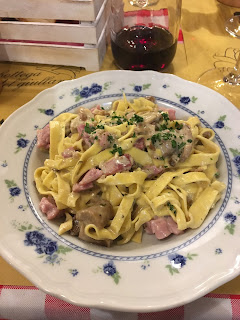 |
| Pasta With Speck |
We went to an excellent local restaurant or Osteria. An Osteria is a place that sells wine and simple food. We found a haven at Hosteria La Bottega del Giullare. The dishes here are traditional local fare, all made from scratch. We shared a carafe of the local house red wine, which was SO delicious. I had a tagliatelle pasta with fresh porcini mushrooms and speck. Now, "speck" in Germany is a type of bacon. Here in Italy speck is dry-cured, lightly smoked ham. In the pasta dish, the speck's saltiness balances the juiciness of the mushrooms, and the light creamy sauce pulls it all together so well. I am actually drooling as I write this, I remember every delicious bite of my lunch in Narni.
 |
| The Liberated Hen! |
There are lots of things to do in Narni; fabulous museums, ancient churches with incredible frescoes that date back to St Francis's time, and Narni Underground tours, Another great place to explore is the Rocca Albornoz of Narni. The Rocca is a big castle on the very top of the hill above the town. Also, just out of Narni, there is the Benedictine Abbey of San Cassiano, which dates back to the 10th century.
Narni has a branch of the University of Perugia, so it seems to have lively and youthful energy even when most things are shut down for the Christmas holidays. There is a performing arts theatre in the main square and lots of funky restaurants and art installations all around town.
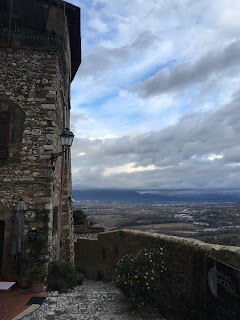 |
| Nera River Valley |
Narni is a place I will return to one day to explore the rich Umbrian history. I just wish it were as simple to get to Narni as stepping through an enchanted wardrobe.

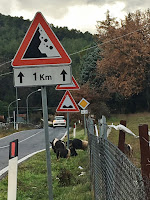
No comments:
Post a Comment